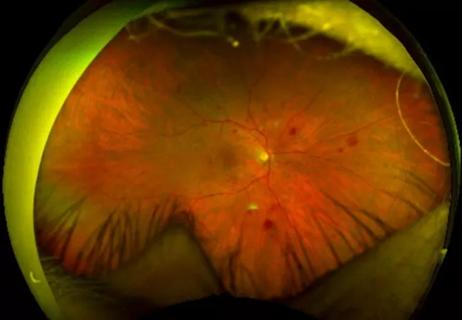Evidence mounts that these diabetes and obesity drugs may protect eyes, not endanger them

Evidence is mounting that glucagon-like peptide-1 (GLP-1) receptor agonist drugs used to treat diabetes and obesity have protective effects across numerous organ systems. A new study by Cleveland Clinic Cole Eye Institute reports that this medication class also may protect against development of nonexudative age-related macular degeneration (AMD) — and do so more effectively than other drugs previously proposed to lower AMD risk.
Advertisement
Cleveland Clinic is a non-profit academic medical center. Advertising on our site helps support our mission. We do not endorse non-Cleveland Clinic products or services. Policy
GLP-1 receptor agonists are believed to have anti-inflammatory and neuroprotective effects in addition to the digestion-slowing and glucose-lowering effects shown to be helpful for treating obesity, Type 2 diabetes and cardiovascular disease. A recent study in Nature Medicine reported that GLP-1 receptor agonists are associated with lower risk of various health conditions, including coagulation disorders, heart conditions, infectious diseases and neurocognitive disorders like Alzheimer’s disease.
“The study in Nature Medicine did not report on eye diseases, however,” says Aleksandra Rachitskaya, MD, a vitreoretinal surgeon at the Cole Eye Institute. “So, our study explored how GLP-1 receptor agonists might impact some of the top blinding diseases — AMD, glaucoma, cataract — in older at-risk patients.”
Earlier studies have indicated the drugs’ ability to lower risk of glaucoma, a correlation with their believed neuroprotective properties. The recent Cole Eye Institute study reinforced those earlier findings in glaucoma while extending the benefit to AMD.
“Others have alluded to the potential protective effect in AMD, but we’re among the first to show it in a large database study,” says lead author Kevin Allan, MD, PhD, a resident at the Cole Eye Institute. “There are still many questions, and we don’t want to overextrapolate, but it’s exciting to find existing drugs that can potentially have an effect on a disease that currently has limited treatment options.”
In the study, published in Ophthalmology, a team led by Drs. Allan and Rachitskaya analyzed data from nearly 10,000 patients older than age 60 in a national database. All had received ophthalmology care and taken GLP-1 receptor agonists for at least five years in the primary analysis.
Advertisement
This cohort was matched with control patients taking alternate diabetes and lipid-lowering medications. To minimize confounders, the groups were matched based on numerous demographic and chronic disease variables.
Compared to patients who took metformin, statins, insulin or aspirin, there was a unanimous reduction in the risk of developing dry AMD by patients who took GLP-1 receptor agonists.
“Other research groups have shown that metformin is potentially protective against developing dry AMD, so we wanted to compare it with GLP-1 receptor agonists,” Dr. Allan says. “We were excited to find that GLP-1 receptor agonists outperformed metformin. We then went a step further and demonstrated a protective effect compared to statins, which also have been thought to be anti-inflammatory and protective across numerous organ systems.”
People taking GLP-1 receptor agonists also had a lower risk of wet AMD compared with people taking statins, insulin and aspirin, and a lower risk of primary open-angle glaucoma compared with people taking metformin, insulin and aspirin. This study joins the ranks of previous publications demonstrating the potential neuroprotective effect of GLP-1 receptor agonists in glaucoma and suggests a need for further prospective trials.
“Validation assessments showed that the favorable effect of GLP-1 receptor agonists on eye disease was evident after three years, suggesting long-term exposure may be required for the protective effect,” says Dr. Rachitskaya, senior author of the study. “As AMD largely occurs in an older population of patients, we further validated the favorable effects in a cohort of patients older than age 75, increasing the rigor of our findings.”
Advertisement
The next step is reproducing the analysis using records of patients at the Cole Eye Institute.
“We can pull more granular data from our patient records than from the national database,” Dr. Rachitskaya explains. “We’re finalizing those data now, which look quite promising. After that, we will need to do a prospective study. The progression of non-neovascular AMD is very slow, so it will require a lot of time to assess.”
There couldn’t be a better time to start, agree Drs. Rachitskaya and Allan. The realm of GLP-1 receptor agonists is changing. Newer drugs may be easier to administer, or more effective, or combined with other medications and lifestyle changes to boost the mode of action and potential benefits.
Concurrently, other studies are revealing more about GLP-1 receptor agonists’ effects on ocular conditions. For example, one Cole Eye Institute study found no association between the drugs and worsening diabetic retinopathy, countering earlier widespread research. Another showed no increase in risk of optic neuropathy. A third study, about the drugs’ effect on glaucoma, is on the horizon.
“We will continue to push forward,” Dr. Allan says. “These drugs are being rapidly adapted across numerous fields of medicine and are important to many patients’ systemic health. We are excited to help pave the way, providing evidence of how these medications may impact our patients’ ocular health.”
Advertisement
Advertisement

New insights on effectiveness in patients previously treated with other anti-VEGF drugs

CFH gene triggers the eye disease in white patients but not Black patients

Study identifies factors that may predict vision outcomes in diabetic macular edema

Flaps, blebs and other surgical options

A primer on sustained release options

Study explores association between sleep aid and eye disease

Early data show risk is 73% higher in patients with lupus, 40% higher in patients with rheumatoid arthritis

Switching medications may decrease treatment burden and macular fluid